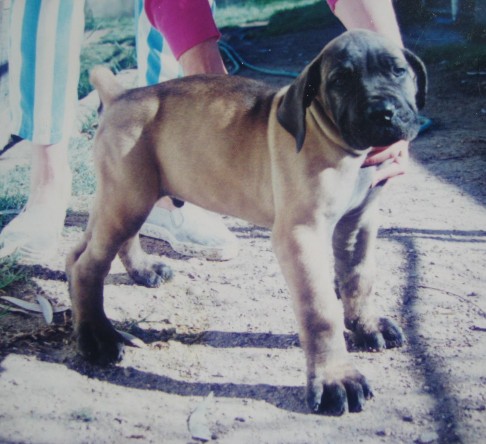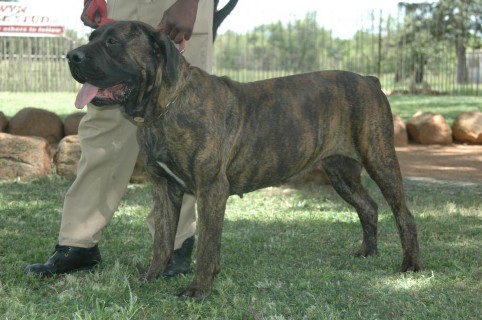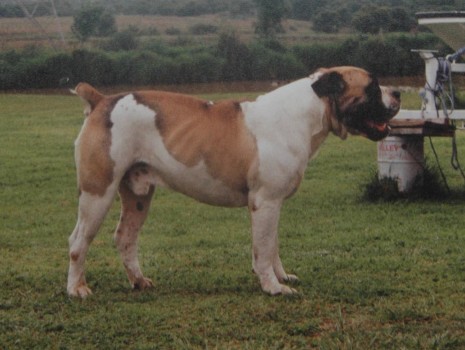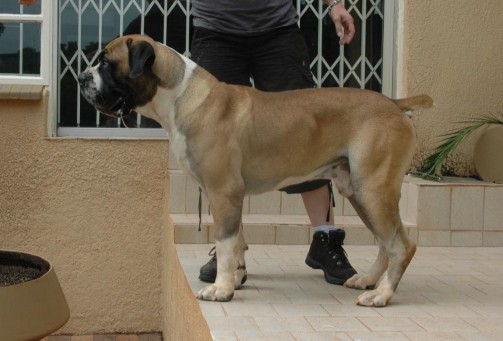
The Coat & Colour
The colours chosen below have been carefully researched and are all colours that will allow the breed to stay healthy by protecting the dog’s skin from the harsh African climate. The large variation in colours has been allowed, because the Boerboel is first and foremost a working dog and what is important is that he can do his job, his colour is secondary. Like the old timers say, a good dog can’t have a bad colour.
The coat is short, dense, smooth and shiny.
Dogs with a coat that is short, smooth and shiny will look much more impressive and muscular than a dog with a dull coat, or a dog with a fractionally longer coat. The density of the coat is important to protect the dog from the elements, and whatever animal they may tangle with. Although it is possible to get short coats that are very dense. At the moment, the dogs with the most protective coats are the ones with hairs that are fractionally longer than ideal.
The recognized colours / colour patterns are (with or without a mask):
The further the mask goes back over the muzzle and head the better. The black pigmentation not only gives a distinctive look but also ensures that the black pigmentation on the nose, lips and around the eyelids is strong and resistant to the harsh UV rays of the sun.

The black mask can go back as far as the ears like with this great looking puppy. This pup is dark brown with a lot of black hairs around his face and on his feet. The black also extends to all his exposed skin like the nose, around the eyes, lips, feet and anus. This pup has as good and more importantly as healthy a colour as someone can hope for.
All shades of Red, Brown and Yellow (fawn).
These are the more preferred colours that the majority of Boerboels come in. I have not reproduced any of the colours here because they all feature throughout the book.
Black.
Brindle : Brindle is a colour pattern with irregular vertical lines of only black hair on Red, Brown or Yellow base.

There are not many brindle Boerboels, although it is a colour that always has great pigmentation. The majority of brindle Boerboels are the dark brindle like the female above. There are lighter shades of brindle which are also acceptable.
Piebald :Piebald is permissible to breed with, but should be discriminated against in the show ring.

If a dog is piebald like this dog and has many endearing qualities that you want in your dogs, especially if you cant find the same traits in dogs with correct colours, then it is better to use a piebald dog that is of excellent quality than a lesser dog even if it has the desired colour.
I think this terminology of being “discriminated against in the show ring” needs to be cleared up. If there are two identical dogs in the show ring, but one is piebald and the other is red or brown, then the piebald dog should be placed below the red or brown dog.
To put these less desirable colours into perspective: A poor temperament or bad movement are far more undesirable than having white markings. A breeder must work within the hierarchy framework when considering what to breed and what not to. Generally, consider the lesser faults as breedable (which are usually cosmetic—colour, coat type, ear set, etc.), and try to breed to a dog who does not have the same faults. Select the puppies in you litter who do not carry the cosmetic, and in not too many generations, you will have cleaned up that line of cosmetic faults. This is certainly not as easy to do with temperament, health or structure faults.
The reasons the Piebald and Irish markings are less desirable are due to the fact that these dogs are more likely to produce dogs that lack the black eumelanin pigmentation than the tan, brown, or red dogs. Both of these colours, which have a lot of white, are also very genetic. When you breed with these dogs, or dogs with Piebald or Irish in their immediate background, pups with this colouration pop up quite often.
Irish Markings :Irish Markings are permissible to breed with, but should be discriminated against in the show ring. (Same as above.)

Irish markings contain three colours, tan, white and black. As long as the nose, eyes, lips and anus have black pigmentation the Irish or Piebald marked dog should not have any problems with getting skin cancer. The only trait that comes along with the piebald and Irish marked dogs that is a physical negative is that often their pads on their feet are white. White feet are often more tender than black pads and take longer to toughen up through work. Dogs with white pads are more likely to go lame when doing long days walking or running.
All these colours and colour patterns should be accompanied by good pigmentation.
No other colours or colour patterns and tan markings are acceptable.
